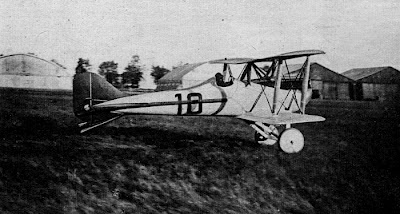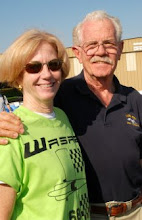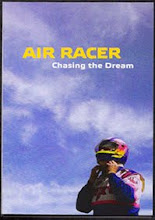The RB-1 before being shipped to France
Everybody has an airplane or airplanes that hit a resonance for them. Some people get really wound up about Piper Cubs; other people see a Q-200 and can’t help but daydream for a few minutes. For some people it may be less severe, for me I have always noticed the Dayton Wright RB-1. Perhaps it’s the picture of twelve guys standing on the wing of the airplane that created questions in my mind as a young engineer. Maybe it’s my unhealthy interest in aircraft with serious forward visibility problems (GeeBee Model Z, Nemesis NXT, Laird Super Solution). For whatever reason I have always noticed the airplane, and a little while ago when Jennifer and I stumbled upon it in the recently renovated “Heroes of the Sky” exhibit in the Henry Ford Museum in Dearborn, Michigan I was pretty excited.
The Dayton Wright RB-1 was debuted at the 1920 James Gordon Bennett Cup Race which was held at the Villesauvage Aerodrome in Etampes, France. The head-designer on the program for Dayton-Wright was Milton C. Baumann and was assisted by Orville Wright, who was a consulting engineer on the program. There were a total of four American designs shipped to France for the race; Glenn Curtiss’ Cactus Kitten and Texas Wildcat, as well as a Verville Scout VCP-1 recently re-engined with a new Packard V-12 and the RB-1. Compared to the other entries, both American and foreign, the RB-1 was a huge technological leap ahead.
The linkages controlling the flap/flaperon position
The RB-1 was a race plane, but more specifically a cantilevered high wing aircraft with retractable main gear and a variable camber wing. The gear was raised by a hand crank on the dash (Long EZ style) which retracted the leading and trailing edge flaps simultaneously with the gear through a system of chains (the process took about 20 seconds). The monocoque fuselage was built of thin strips of wood and doped linen (wood core linen composite construction). The two large side windows had no forward facing compliment, but could be opened slightly to offer the pilot some forward view. The engine was a 250hp Hall Scott water cooled inline six, which was cooled by a large radiator directly behind the propeller. At the time the engine was criticized by other racers for being of WWI vintage and therefore lower power.
Nieuport 29V the winner of the 1920 James Gordon
Bennett Cup Race
The wing was 21 feet long and built out of large pieces of balsa, carved to shape and covered with doped linen. The leading and trailing edge flaps were retracted by a series of external linkages (on the top surface of the wing) with the trailing edge flaps doubling as ailerons. For initial flight test, while the retractable landing gear was tested, a conventional strut braced wing was installed. After shipping the airplane to France, the race pilot Howard Rinehart found the directional stability of the airplane wanting and added two vertical surfaces to the tips of the horizontal.
Etampes, France
September 28th marked the first race of the airplane. On a practice lap in days previous, the RB-1 had reached a speed of 165mph (Howard had commented on the ground that the engine had not been making full power); the crowd expected the airplane to make its design point of 200mph. The race would be three laps of a 100 km course; six aircraft started the race (only two American aircraft, the RB-1 and the Verville). A spectator commented that the RB-1 with her gear retracted resembled a huge flying mackerel. Twenty minutes later Howard landed the RB-1 distraught, a cable had failed causing him to end the race early (sabotage was later suspected). Only two aircraft finished the race, both flying for France. Rudolph Schroeder pulled the Verville out of the race with its new Packard overheating and neither of the Curtiss designs started the race.
Aircraft preparing to race at Villesauvage Aerodrome in Etampes France
Joseph Sadi-Lecointe won the day in his Nieuport 29V at 168 mph. He would go on to set a world absolute speed record in that airplane twelve days later at 184 mph (he held the record two more times, one of which in the same Nieuport with the canopy faired over). The first major record to be held by an aircraft with a retractable undercarriage was Howard Hughes in the H-1 which set the speed record for land planes on 9-13-35 at 352mph (he could not surpass the Italian floatplane record at 440 mph set 10-23-34). The first absolute speed record to be set with retractable undercarriage was Hans Dieterle in the He-100 at 463mph set 3-30-39 (19 years after the RB-1). The first American aircraft with retractable undercarriage to hold the absolute speed record was Albert Boyd in a P-80 at 623.73 mph set 6-19-47 (27 years after the flights of the RB-1). The RB-1 was not raced again, and somehow survived the test of time to be displayed at the Henry Ford Museum. The airplane is nicely displayed where it can be viewed from many angles and shares the room with Glenn Curtiss’ winning propeller from the first air race at Reims in 1909. Also on display is the Sikorsky VS300A (credited as the first single rotor helicopter).
The RB-1 as displayed at the Henry Ford Museum
O'Leary, Michael. “Dayton-Wright RB-1.” Air Classics, Nov 2003
Davidson, Keith. Record Lists/Racing & Record Aircraft Special Interest Group International Plastic Modellers’ Society. Dec 31, 2006. IPMS.org
Author Unknown. James Gordon Cup Races/Society of Air Racing Historians. Aug 26, 2010. AirRace.org

























